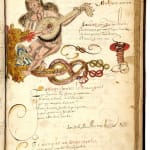-
Artworks
![[Renaissance French illuminated manuscript songs and music], Superb collection of French Vernacular ‘Noëls’, extravagantly illustrated by a late-16th century embroiderer, [ca. 1600]. [Normandy].](data:image/gif;base64,R0lGODlhAQABAIAAAAAAAP///yH5BAEAAAAALAAAAAABAAEAAAIBRAA7)
![[Renaissance French illuminated manuscript songs and music], Superb collection of French Vernacular ‘Noëls’, extravagantly illustrated by a late-16th century embroiderer, [ca. 1600]. [Normandy].](data:image/gif;base64,R0lGODlhAQABAIAAAAAAAP///yH5BAEAAAAALAAAAAABAAEAAAIBRAA7)
![[Renaissance French illuminated manuscript songs and music], Superb collection of French Vernacular ‘Noëls’, extravagantly illustrated by a late-16th century embroiderer, [ca. 1600]. [Normandy].](data:image/gif;base64,R0lGODlhAQABAIAAAAAAAP///yH5BAEAAAAALAAAAAABAAEAAAIBRAA7)
![[Renaissance French illuminated manuscript songs and music], Superb collection of French Vernacular ‘Noëls’, extravagantly illustrated by a late-16th century embroiderer, [ca. 1600]. [Normandy].](data:image/gif;base64,R0lGODlhAQABAIAAAAAAAP///yH5BAEAAAAALAAAAAABAAEAAAIBRAA7)
![[Renaissance French illuminated manuscript songs and music], Superb collection of French Vernacular ‘Noëls’, extravagantly illustrated by a late-16th century embroiderer, [ca. 1600]. [Normandy].](data:image/gif;base64,R0lGODlhAQABAIAAAAAAAP///yH5BAEAAAAALAAAAAABAAEAAAIBRAA7)
![[Renaissance French illuminated manuscript songs and music], Superb collection of French Vernacular ‘Noëls’, extravagantly illustrated by a late-16th century embroiderer, [ca. 1600]. [Normandy].](data:image/gif;base64,R0lGODlhAQABAIAAAAAAAP///yH5BAEAAAAALAAAAAABAAEAAAIBRAA7)
![[Renaissance French illuminated manuscript songs and music], Superb collection of French Vernacular ‘Noëls’, extravagantly illustrated by a late-16th century embroiderer, [ca. 1600]. [Normandy].](data:image/gif;base64,R0lGODlhAQABAIAAAAAAAP///yH5BAEAAAAALAAAAAABAAEAAAIBRAA7)
[Renaissance French illuminated manuscript songs and music]
Superb collection of French Vernacular ‘Noëls’, extravagantly illustrated by a late-16th century embroiderer, [ca. 1600]. [Normandy].A unique manuscript witness of 16th century vernacular songs and music.
Visually arresting example of this 16th century attempt to record the purely oral traditions of vernacular Christmas and Advent music in a small town in provincial Normandy (Verneuil-sur-Avre). “Most of these spiritual songs, still touching and naive, often inconsequential, have not been passed down to us; oblivion was to erase, in their simplicity and grace, these humble productions of a popular genre, often confined solely to the memory of those who repeated them from generation to generation…” (Allard). According to the Grove Dictionary of Music, “no 17th century printed collections [of Noëls] survive with notated music, although a few manuscript sources include melodies”.Further images
Folio, (315 x 220 mm). French manuscript in a neat ‘Allemand’ hand on paper, ca. 1600, with a few leaves in a late 17th century cursive. 180 ff, illuminated with 59 large (sometimes full page) capricci in vibrant colors, some bordering on the grotesque, and incorporating highly imaginative depictions of fantastic beasts, musical instruments, and human figures. Folios 1–3, 41, 131–2, 164, and 179 were removed sometime before 1895 (see below). Bound in 17th century gilt-ruled brown morocco with owner’s names (Marie Poullain and Michel du Four) gilt-stamped on covers. A transfixing example of a lost genre of vernacular literature.
Provenance: 1.) Michel du Four and Marie Poullain (contemporary gilt lettering on covers), conceivably a marriage gift. One of the two coats of arms on f. 52v (argent, a chevron gules accompanied by three roses of the same, on chief a winged cherub’s head) does appear to derive from that of the Du Four family of Normandy (see Jougla de Morenas, Grand armorial de France nos. 16009 and 16011). We have not been able to identify the other coat of arms but it seems likely that it is that of Marie Poullain (or Poulain). The winged cherub’s head of the Du Four arms reappears in the initial on f. 99, and both coats of arms appear in the initial on f. 100r (on a pedestal supporting a naked woman playing the cornet), the Du Four arms flanked there by the monograms ‘PF’ (for Pierre Fleuri?) and ‘BV’ (these four letters appear again as a single monogram within the initial on f. 166r). The mysterious monogram ‘PALI’ appears within the initial on f. 45r . 2. Ernest-Gabriel, marquis des Roys (1836–1903). 3. Latterly in a German private collection.
Join our mailing list
* denotes required fields
We will process the personal data you have supplied in accordance with our privacy policy (available on request). You can unsubscribe or change your preferences at any time by clicking the link in our emails.
![[Renaissance French illuminated manuscript songs and music], Superb collection of French Vernacular ‘Noëls’, extravagantly illustrated by a late-16th century embroiderer, [ca. 1600]. [Normandy].](https://artlogic-res.cloudinary.com/w_1600,h_1600,c_limit,f_auto,fl_lossy,q_auto/artlogicstorage/hsrarebooks/images/view/9d3f575ed884aa98c04a115e342912c6j/hsrarebooks-renaissance-french-illuminated-manuscript-songs-and-music-superb-collection-of-french-vernacular-no-ls-extravagantly-illustrated-by-a-late-16th-century-embroiderer-ca.-.jpg)
![[Renaissance French illuminated manuscript songs and music], Superb collection of French Vernacular ‘Noëls’, extravagantly illustrated by a late-16th century embroiderer, [ca. 1600]. [Normandy].](https://artlogic-res.cloudinary.com/w_1600,h_1600,c_limit,f_auto,fl_lossy,q_auto/artlogicstorage/hsrarebooks/images/view/14052e6f8f81f3b0f14c3eea16759e43j/hsrarebooks-renaissance-french-illuminated-manuscript-songs-and-music-superb-collection-of-french-vernacular-no-ls-extravagantly-illustrated-by-a-late-16th-century-embroiderer-ca.-.jpg)
![[Renaissance French illuminated manuscript songs and music], Superb collection of French Vernacular ‘Noëls’, extravagantly illustrated by a late-16th century embroiderer, [ca. 1600]. [Normandy].](https://artlogic-res.cloudinary.com/w_1600,h_1600,c_limit,f_auto,fl_lossy,q_auto/artlogicstorage/hsrarebooks/images/view/59f03a923d8cbecb07ec6b9b3ffe7bbbj/hsrarebooks-renaissance-french-illuminated-manuscript-songs-and-music-superb-collection-of-french-vernacular-no-ls-extravagantly-illustrated-by-a-late-16th-century-embroiderer-ca.-.jpg)
![[Renaissance French illuminated manuscript songs and music], Superb collection of French Vernacular ‘Noëls’, extravagantly illustrated by a late-16th century embroiderer, [ca. 1600]. [Normandy].](https://artlogic-res.cloudinary.com/w_1600,h_1600,c_limit,f_auto,fl_lossy,q_auto/artlogicstorage/hsrarebooks/images/view/523274591f3d7443a7f5cedde40c8eabj/hsrarebooks-renaissance-french-illuminated-manuscript-songs-and-music-superb-collection-of-french-vernacular-no-ls-extravagantly-illustrated-by-a-late-16th-century-embroiderer-ca.-.jpg)
![[Renaissance French illuminated manuscript songs and music], Superb collection of French Vernacular ‘Noëls’, extravagantly illustrated by a late-16th century embroiderer, [ca. 1600]. [Normandy].](https://artlogic-res.cloudinary.com/w_1600,h_1600,c_limit,f_auto,fl_lossy,q_auto/artlogicstorage/hsrarebooks/images/view/1b054716b141030c9f0705f1ca2dd765j/hsrarebooks-renaissance-french-illuminated-manuscript-songs-and-music-superb-collection-of-french-vernacular-no-ls-extravagantly-illustrated-by-a-late-16th-century-embroiderer-ca.-.jpg)
![[Renaissance French illuminated manuscript songs and music], Superb collection of French Vernacular ‘Noëls’, extravagantly illustrated by a late-16th century embroiderer, [ca. 1600]. [Normandy].](https://artlogic-res.cloudinary.com/w_1600,h_1600,c_limit,f_auto,fl_lossy,q_auto/artlogicstorage/hsrarebooks/images/view/e44d9210d0b3c51358a2cbaa00d81607j/hsrarebooks-renaissance-french-illuminated-manuscript-songs-and-music-superb-collection-of-french-vernacular-no-ls-extravagantly-illustrated-by-a-late-16th-century-embroiderer-ca.-.jpg)
![[Renaissance French illuminated manuscript songs and music], Superb collection of French Vernacular ‘Noëls’, extravagantly illustrated by a late-16th century embroiderer, [ca. 1600]. [Normandy].](https://artlogic-res.cloudinary.com/w_1600,h_1600,c_limit,f_auto,fl_lossy,q_auto/artlogicstorage/hsrarebooks/images/view/8eb0522d10284d3493491b943faa1c7fj/hsrarebooks-renaissance-french-illuminated-manuscript-songs-and-music-superb-collection-of-french-vernacular-no-ls-extravagantly-illustrated-by-a-late-16th-century-embroiderer-ca.-.jpg)






